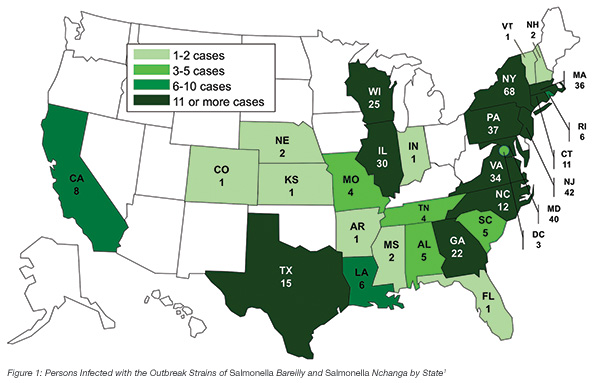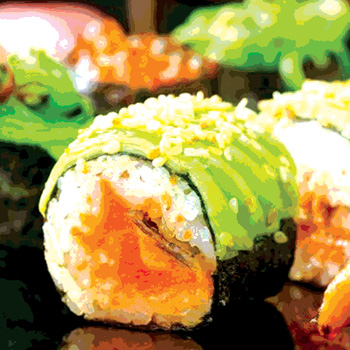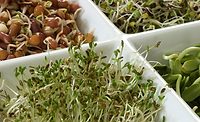In the spring of 2012, the U.S. Food and Drug Administration (FDA) began to hear from the U.S. Centers for Disease Control and Prevention (CDC) and other public health partners about cases of salmonellosis. The case count grew quickly. In the first week of April, 93 illnesses were reported. The next week there were 116, and a week later there were 139. By early May, the number of cases had nearly doubled. The final count: 425 people had been reported ill by the end of the outbreak. But by using traceback analysis, FDA was able to follow a trail of tuna shipments to its source, leading to the recall 58,000 pounds of frozen tuna and helping prevent additional illnesses.
FDA, CDC, and state and local agencies worked together in a huge effort to determine whether tuna imported from India was the culprit. During a multistate foodborne disease outbreak, public health partners conduct surveillance to identify and interview people who have become ill. CDC serves as lead coordinator to help detect the outbreak, define its size and extent, and to identify the source.
 Investigators determined that this outbreak involved two strains of Salmonella—Salmonella Bareilly and Salmonella Nchanga (Figures 1 and 2). Once the interviews with case patients began to point toward sushi as a possible carrier of the outbreak strains of Salmonella, there remained the complex task of figuring out what ingredient in the sushi might have been contaminated.
Investigators determined that this outbreak involved two strains of Salmonella—Salmonella Bareilly and Salmonella Nchanga (Figures 1 and 2). Once the interviews with case patients began to point toward sushi as a possible carrier of the outbreak strains of Salmonella, there remained the complex task of figuring out what ingredient in the sushi might have been contaminated.
 Because the evidence pointed to an FDA-regulated product, FDA took the lead on determining how the outbreak occurred, looking for ways to control it and identifying ways to prevent future outbreaks, which included testing foods, assessing food safety measures in restaurants and food processing facilities, and announcing food recalls.
Because the evidence pointed to an FDA-regulated product, FDA took the lead on determining how the outbreak occurred, looking for ways to control it and identifying ways to prevent future outbreaks, which included testing foods, assessing food safety measures in restaurants and food processing facilities, and announcing food recalls.
FDA also traces foods to their origins, and in this investigation, the traceback was a key means of identifying the food carrying Salmonella. Such tracebacks are painstaking efforts that require investigators to be both detectives and scientists. Teams must track a contaminated food or ingredient back to its source so that it can be taken off the market, preventing future illnesses. This process often requires collecting, reviewing and analyzing hundreds—sometimes thousands—of invoices and shipping documents. Investigators then connect that information to other bits and pieces gained from interviewing staff working at firms in the supply chain and from observations of investigators visiting the firms.
Searching for Clues in the Maze
All investigators know traceback is laborious. They might as well be looking for clues in a maze. First, the investigator must enter the labyrinth. But which of the hundreds of entrances is the right choice? Once inside, investigators have even more decisions to make. From the very beginning until the end, scientific methods and investigative skills must be harnessed to identify the source of the outbreak. And once they reach the center of the maze, investigators must still find their way back, carefully choosing between pathways with more offshoots, dead ends, twists and turns. If they do everything right, investigators exit the maze with a map, new knowledge and understanding that can be used to prevent additional illnesses.
But the size of the outbreak can have a dramatic impact on the complexity of the investigation. Imagine standing before a maze, one that begins with just a few entrances but grows to have 425 entrances, each representing a reported illness in the outbreak tally. That was essentially the challenge presented to investigators during the 2012 investigation of the salmonellosis outbreak linked to tuna. To determine how these people got sick, investigators stepped through certain doorways and followed clues. Analysts identified clusters of illnesses, selecting clusters at four restaurants to trace back. Then investigators pain-stakingly reviewed thousands of invoices and records from 45 companies that could have supplied the tuna to the restaurants. This allowed them to rule out 44 firms. The one remaining company supplied all four restaurants. They had navigated the maze and created a map, which we call traceback.
Inside the Investigation
It is hard to grasp the effort and difficulties involved in a traceback investigation. Before the restaurants and the supplier at the heart of the 2012 investigation were identified, this is what happened:
State and local health officials on the front lines identified and interviewed patients, working with CDC to determine what food was making people sick. The outbreak grew and as more information became available, the leading suspect became seafood, specifically spicy tuna sushi. But if people were made ill by sushi, what ingredient in the sushi might be carrying Salmonella? The candidates included mayonnaise, sesame seeds, fresh and frozen tuna, hot sauce, seaweed and rice.
FDA worked with state agencies to identify the brands of ingredients in common use at restaurants. The effort excluded all but tuna as the most likely candidate, and the traceback began.
During this step, the traceback team looks for clusters of patients who reported eating or shopping at a common location. It is important that the patients have a good memory of what they ate, or their purchases were documented in some way, such as with a grocery store shopper card or a purchase receipt.
Ideally, the team will identify at least three pathways to trace in different geographic areas. They must also determine what time period to investigate. If the time frame is too wide, it could bog down the investigation and collection of records. If it is too narrow, the team may miss vital information.
“It takes a team effort to stop an outbreak,” says Kathleen Gensheimer, M.D., the director of FDA’s Coordinated Outbreak Response and Evaluation (CORE) Network. “The FDA district offices, the federal, state and local authorities, scientists at FDA headquarters and in the field, and members of industry, everyone brings something to the table. Without that teamwork, it just couldn’t happen.”
During the investigation, investigators had to gain an understanding of each supplier’s handling of the tuna. Practices such as stock rotation and inventory control can help narrow which suppliers to follow. The availability and accuracy of records can make or break a traceback investigation at this point.
“Recordkeeping varies from one company to the next, so with each supplier you have to learn and understand a new record system and new operating practices,” says Gensheimer. “Many companies keep excellent records, but when recordkeeping is not good, it can lead to a dead end.”
Ultimately, FDA followed the trail of tuna shipments from the four restaurants through 45 separate suppliers before finding the source of the bad tuna.
Going Back to Move Forward
Finding the common supplier, though, is only half the battle. When FDA knows where the food came from, there’s still another question. Where else did this food go?
The next step is a trace-forward analysis, which can identify new pathways of exposure that need to be blocked. Analysts examined shipping records, invoices and information on product-handling practices to track shipments from the common tuna supplier to 20 additional restaurants that served tuna to customers who reported becoming ill during this outbreak.
The results of these traceback and trace-forward investigations quickly led to the recall of 58,000 pounds of frozen tuna and an alert to FDA inspectors at U.S. points of entry to detain further shipments of frozen tuna from this supplier to prevent future illness.
The Evolving Process
Although the traceback method was used as far back as the 1920s during a typhoid outbreak linked to fresh oysters in New York City, Chicago and Washington, DC, the increasingly global marketplace makes the technique both more important and more challenging. FDA began to place more emphasis on traceback in the late 1980s and 1990s, as Salmonella Enteritidis outbreaks were linked to fresh shell eggs, and relied on it in the late 1990s as more outbreaks were detected.
“The FDA’s focus on traceback really goes hand in hand with the evolution of FDA’s mission from one focused primarily on enforcement to a mission focused more on prevention,” says Jack Guzewich, a former senior adviser on environmental health at FDA. “We began to broaden our view of what evidence we could act upon—going beyond positive laboratory samples to acting on epidemiological evidence. That made a huge change.”
Historically, you can chart the rapid development of FDA’s traceback process from outbreaks of cyclosporiasis linked to raspberries in the late 1990s. Prior to that, FDA traceback investigations were for packaged products, in which much of the needed information is on the package label and, because these types of product have a longer shelf life, the risk of illness is prolonged.
“This meant a fairly straightforward traceback process could be followed,” says Guzewich. “Fresh produce, on the other hand, often has no such label, so a much more complex and difficult traceback effort is required.”
FDA adopted a traceback process in use by CDC, and state regulatory and public health agencies at the time and developed it further. Shortly afterward, FDA issued its first guidance to its staff for conducting traceback investigations related to produce, which led to the development of a traceback course in the late 1990s.
In 1995, following the advent of PulseNet, a database of the DNA information from bacteria related to illnesses across the country, health officials could identify multistate outbreaks that might previously have gone unrecognized.
“FDA depends on close collaboration with partners at CDC, state and local public health, and food safety agencies to identify the outbreaks and to provide much of the information used in tracebacks,” notes Guzewich. “They could not be accomplished without this cooperation.”
Into the Future
Over time, FDA’s traceback methods have become more refined, and the agency has offered a course so that its staff and members of state and local agencies can learn about the techniques and methods developed and standardized over the last few decades.
“With this course, we want to formalize the traceback process and make what we’ve learned available to health officials across the country,” says Katie Vierk, a developer of the course and a team leader at CORE. “Responding to an outbreak is a very collaborative effort. If everyone is aware of and using the same process, it is a tremendous help during an outbreak response.”
The course covers all the steps in the process, from logistics to the information that must be collected, and how to best analyze and present the data.
“All of this is important, because our goal is to be able to document the traceback and, if needed, take appropriate action,” adds Vierk. “At the end of the course, students participate in a simulated traceback exercise using real data. We’re teaching practical, usable skills and we want to demonstrate that right away.”
Congress also had the intention of improving product tracing when the Food Safety Modernization Act (FSMA) was developed. In that legislation, Congress directed FDA to establish pilot projects for produce and processed food to explore and evaluate fast, effective food-tracing methods and technologies.
The pilot projects were completed by the Institute of Food Technologists (IFT), under contract with FDA, culminating in March 2013 with the release of a final report.[2]
IFT consulted with the U.S. Department of Agriculture, state agencies, consumer groups, and the processed food and produce industries on proposed foods and ingredients, and product-tracing technologies for the pilot projects.
The 45 companies volunteering to participate in the pilots included tomato growers in the U.S. and Mexico, an import company, tomato processors, ingredient suppliers, processed food manufacturers, food distributors, retailers and foodservice chains.
Tomatoes were among several foods chosen for testing because they have been involved in a number of significant outbreaks, have a complex food supply chain and were identified by most industry associations as a top candidate for inclusion.
A frozen Kung Pao-style meal containing domestic peanut products, red pepper spice and chicken was also chosen for testing, as were dry versions of this type of meal in which consumers would add their own chicken. Jarred peanut butter was also tested.
In the final report, IFT noted that the pilot participants appeared to have many of the tools and processes in place to contribute to a successful traceback by regulatory agencies, though there were challenges. For instance, most participating firms provided documents that could not be electronically manipulated. The formats of the documents allowed for easy transmittal of information, but forced those trying to use the data to either extract them manually or use an optical character reader. This slowed the analysis of the data and opened it to the potential for errors to be introduced.
In addition, inconsistencies in the terminology, numbering systems, formatting, legibility and language meant that traceback analysts had to spend additional time following up with the firms to make sure the data were accurate.
“The IFT experienced exactly what the FDA experiences in real outbreaks. During an outbreak, people are getting sick and we need to act fast but are stymied by these challenges,” says Sherri McGarry, who is the manager of this project and a senior adviser in FDA’s Office of Food and Veterinary Medicine.
The IFT final report also noted that some participating firms had never considered how their records would need to be pieced together with those of their suppliers in a traceback investigation. The report noted that the participants were surprised by the process used and expected an experience more like a mock recall in which they would be provided with a lot number and asked to identify where the product was sent.
“Most firms have a good handle on what comes in, and a good handle on what goes out, but there’s a gap in the middle,” says McGarry. “Here’s an example. Let’s say you have five shipments of a type of fruit from five different growers. Some of that fruit was repackaged and sent out unprocessed, while some of it was put into fruit salads. If a firm can tell you how the incoming shipments link to the specific outgoing shipment, it would speed traceback dramatically as we link shipments again and again through the supply chain.”
An added advantage was that industry participants were able to identify benefits from improved recordkeeping. They reported that, depending on their place in the supply chain, better recordkeeping could potentially improve internal processes, help expand distribution, reduce insurance costs and improve consumer confidence and brand reputation.
The findings of the pilot projects and input from stakeholders will help FDA recommend product-tracing improvements in a report to Congress, as required by FSMA. Also, FDA will use the information from these pilot projects and earlier studies to draft a proposed regulation, also required by FSMA, to establish recordkeeping requirements for facilities that manufacture, process, pack or hold high-risk foods to help in tracing products more quickly, reducing illnesses in the event of food contamination.
“Traceback is an important part of any foodborne outbreak response. Once epidemiology identifies a common food as the vehicle for the bacteria or virus, we still may not know what specific ingredient is causing the problem,” says Gensheimer. “At that point, traceback can be used to help identify the sources of ingredients and, potentially, the source of the ingredient carrying the contamination. Once we know that, we can get the product off the market.”
Douglas Karas is a communications specialist with the CORE Network and has 17 years of experience in public affairs, most recently as a press officer for FDA.
References
1. www.cdc.gov/salmonella/bareilly-04-12/index.html.
2. www.fda.gov/food/guidanceregulation/fsma/ucm270851.htm.
Traceback Investigations: Mapping the Maze




